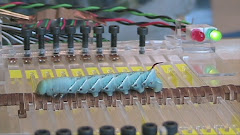 People often ask me what I do with caterpillars and poke their head toward my various apparatus. Well, this one is obvious! "Why are you dipping caterpillars into water?"
People often ask me what I do with caterpillars and poke their head toward my various apparatus. Well, this one is obvious! "Why are you dipping caterpillars into water?"Together with a hard working undergraduate research student, we perform an simple experiment what Akimidis would have appreciated very much. By dipping the caterpillar progressively, we could map the volume contribution from head to tail by quantifying the buoyancy. This simple method easily
 beats the fancy 3D laser scanning, MRI imaging, and X-ray data our predecessors attempted before us in this lab. The only special skill is to tam the caterpillars to stay still during the measurment. Well, this is what caterpillars do in nature -- "I'm not here!!" Nevertheless, cold water can be irritating, thus controling the temperature is critical. The total emersion directly gives the overal body density of any given caterpillar.
beats the fancy 3D laser scanning, MRI imaging, and X-ray data our predecessors attempted before us in this lab. The only special skill is to tam the caterpillars to stay still during the measurment. Well, this is what caterpillars do in nature -- "I'm not here!!" Nevertheless, cold water can be irritating, thus controling the temperature is critical. The total emersion directly gives the overal body density of any given caterpillar.Another collateral experiment was something Sir Issac Newton would have been quite interested. We balance a lightweight beam with the caterpillar on it by providing a pivot support below the beam. By measuring the moment force at one end, and shift the pivot across the animal, the mass distribution can be easiliy calculated. The first immediate result is the center of mass for the animal. Combining this data with the above volume map, we can reconstruct a density map across the animal body length.
Density map and mass distribution are two crucial parameters for any biomehcnaical model of a soft body. In addition, the density change across different animal sizes indirectly reflect the trachael volume and respiratory capacity, since most other tissues in the body are similar to water density. Open gas cavities also affect the use of hydrostatic skeleton for a soft-bodied animal. If some caterpillars don't use their hydrostatic skeleton for locomotion, maybe their bodies are too leaky for economic pressurization.
PS: The caterpillar in the lower photo was groomming after a water bath!!

.jpg)